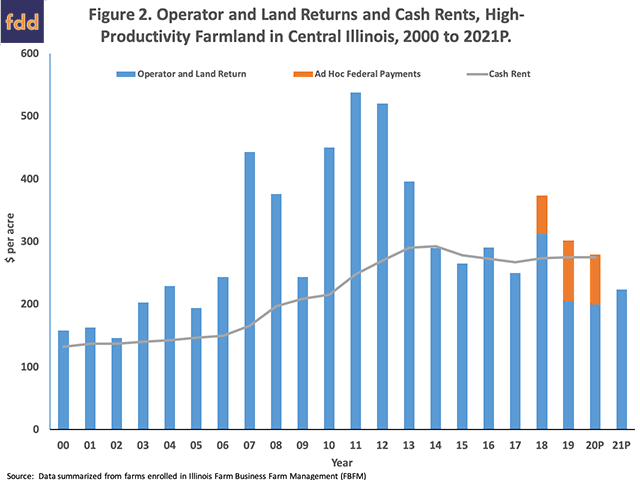Cash Rents Face Pressure
Weather, Government Aid May Dictate Whether Rents Hold Steady or Decline
INDIANOLA, Iowa (DTN) -- Cash rent negotiations between farm tenants and landowners will be tough again this fall as farmers face negative cash flows in 2021.
Ad hoc federal payments in 2019 and 2020 kept many farmers at or above breakeven, but it's uncertain that aid will continue in 2021, explained ag economist Gary Schnitkey at the University of Illinois.
His profit projection for highly productive farmland in central Illinois in 2021 says farmers could pay $224 per acre in land rent and break even. However, rents in this area run $275 per acre on average.
"The trend in cash rents is to stay the same or be slightly lower," said Schnitkey. Slightly lower means $10 to $15 per acre lower in some cases, explained Schnitkey. "However, there is a credible argument they should be $50 less, particularly in Iowa where yields will be lower. Most of Illinois is looking at good yields."
The Illinois numbers represent a farm that is 50% corn and 50% soybeans with trend yields of 217 bushels per acre (bpa) and 68 bpa, respectively. It includes a cash price of $3.40 per bushel (bu) for corn and $8.50 per bu soybeans and $30 per acre total from PLC (Price Loss Coverage) government payment ($60/acre corn, $0/acre soybeans). It does not factor in any other government payments in 2021.
"The coronavirus has not been kind to prices, particularly corn," Schnitkey noted.
Ben Riensche, who farms in northeast Iowa near Jesup, agrees.
"The corn and soybean market have remained at multi-year lows for months," he said. "Government payments earlier this summer amounted to a paltry few dollars per acre. Nothing like the $200 per acre revenue declines coming from the decrease in the value of the corn crop."
P[L1] D[0x0] M[300x250] OOP[F] ADUNIT[] T[]
Between the market and the weather, cash rents will be very neighborhood specific for 2021, said Doug Hensley, president of real estate services at Hertz Farm Management in Nevada, Iowa.
"If forced to make a decision today, things look weaker," Hensley said. "We'll have a better idea after harvest. We still don't know if there will be another government emergency payment for farmers. If we have government support and if you grow the bushels, rents will remain steady."
That means most farmers don't have the information they need to properly negotiate.
The average cash rent in Iowa in 2020 was $222 per acre. Northeast Iowa had the highest average cash rents at $248 per acre.
The average cash rent for highly productive land in central Illinois is estimated at $275 per acre with the statewide average coming in at $222 per acre. Indiana's average statewide cash rent was $194 per acre in 2020.
"It's really too early to negotiate without all the information you need," Hensley said.
FALL NEGOTIATIONS
Iowa has a law that says landlords or tenants have to terminate a lease by Sept. 1 if they want to change the terms, or the lease stays in effect for the following year. As a rule, most professional farm management companies and many landowners send out lease terminations to all their tenants in August to keep open the option to negotiate the lease contract later in the year.
Most Iowa farm tenants understand a notice to terminate their lease does not mean the landowner wants to rent the farm to someone else.
"Sometimes we have to explain that to a new tenant," said Randy Dickhut, senior vice president of real estate operations for Farmers National Company, based in Omaha. "It just helps keep our options open."
Dickhut recognizes this is a financially difficult year for farmers. He predicts steady to slightly softer cash rents for 2021.
"If you're in an area with really good yields and marketed early and received government payments, cash rents should stay steady. However, in hard-hit areas, there will be more downward pressure on rents," Dickhut said.
The federal government kept farmers afloat in 2020, according to the University of Illinois's calculations. Total operator and land return is projected at $280 per acre with $80 coming from ad hoc disaster payments. Paying $275 average cash rent, the average farm operator would lose $75 per acre without the federal aid this year. Even with the federal aid, the farmer's return is only projected at $5 per acre. That doesn't leave a lot of cushion to keep rents where they are in the coming year.
"I would say if we get an additional round of federal aid, in Illinois, things will be okay," said Schnitkey. "We'll get by, but that is premised on high yields and federal aid."
Competition for farmland continues to prop up cash rental rates and many landlords and tenants are waiting to see the results of the election and if Congress passes another economic stimulus package.
However, "at some point very soon, bankers and landlords are going to find out the hard way you can't get blood out of a turnip," Riensche said.
Elizabeth Williams can be reached at talk@dtn.com
(c) Copyright 2020 DTN, LLC. All rights reserved.





